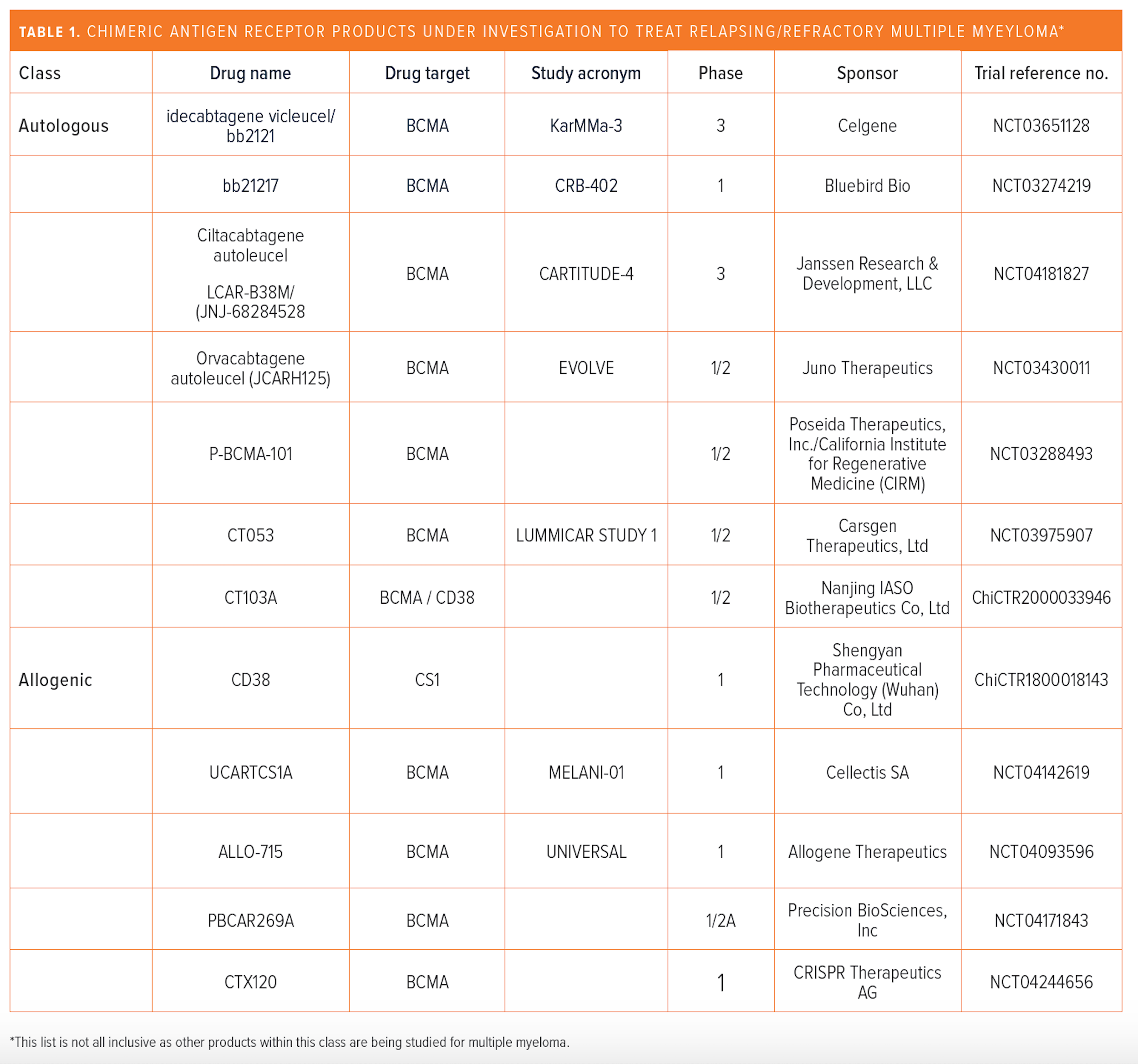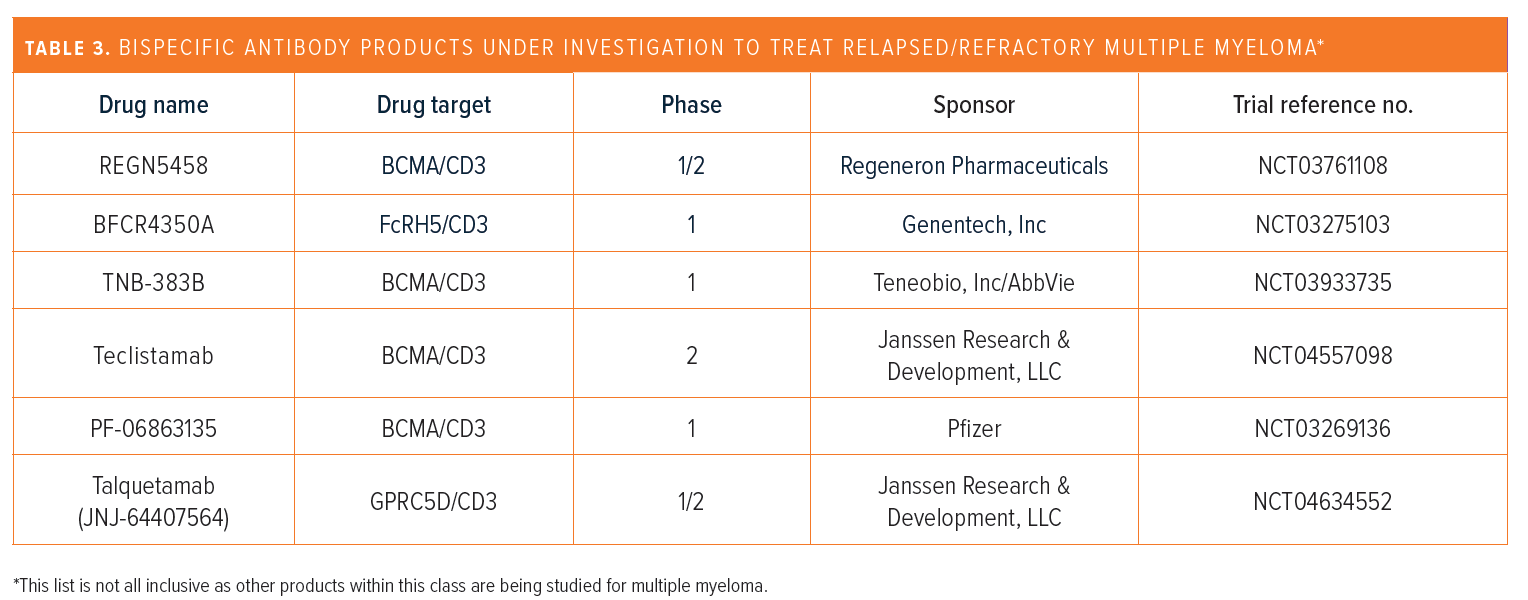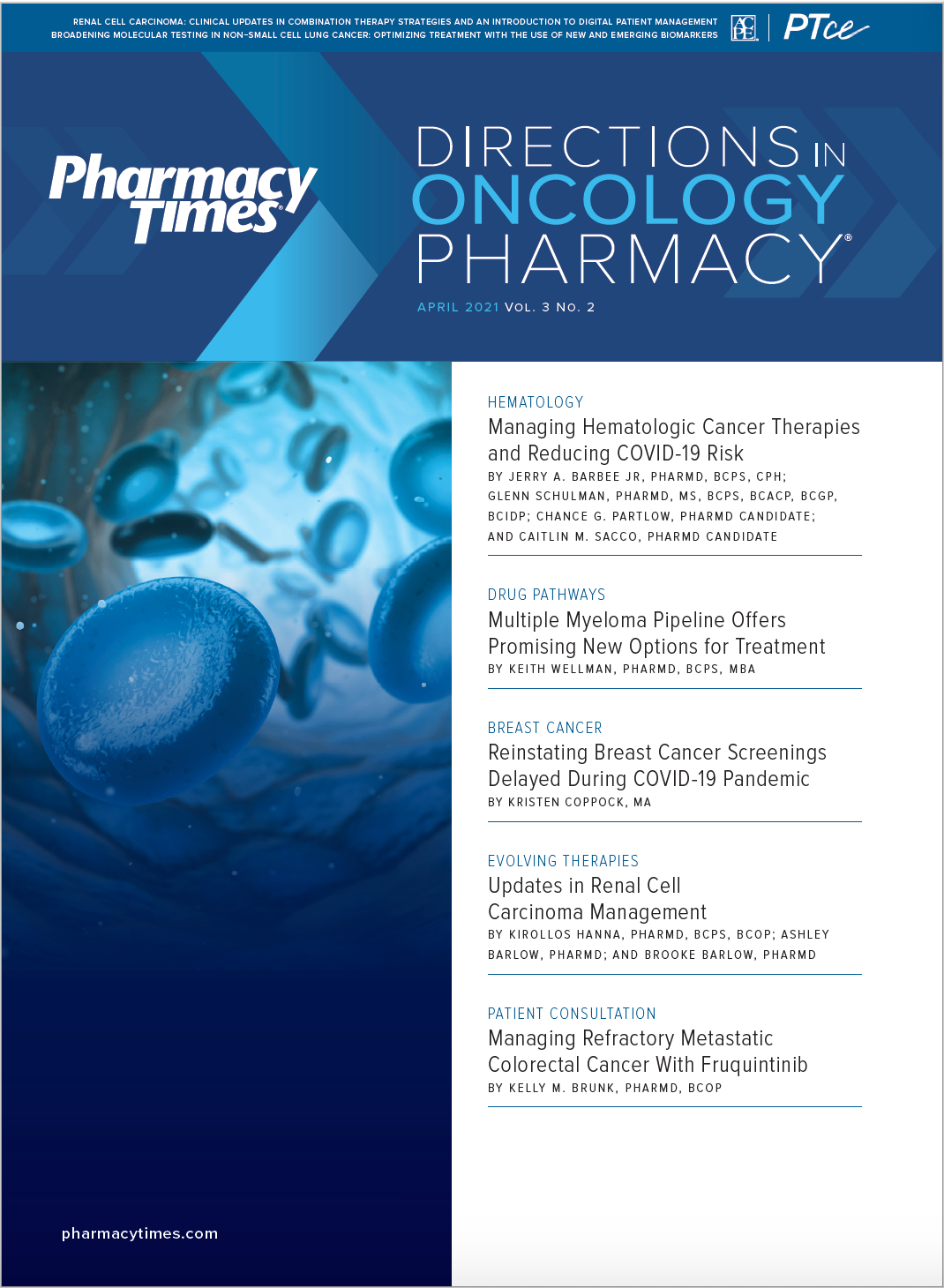Publication
Article
Pharmacy Practice in Focus: Oncology
Multiple Myeloma Pipeline Offers Promising New Options for Treatment
Author(s):
Novel therapeutics under investigation include CAR T-cell therapies, antibody-drug conjugates, and bispecific antibodies, as well as other unique drugs.
The multiple myeloma pipeline has seen plenty of activity over the last several years, providing a much-needed boost in the fight against a disease that is expected to see over 30,000 new cases this year.1 Innovation continues to bring optimism as we monitor the progress of several antineoplastics and immunotherapies in clinical trials using new technology, unique mechanisms of action, and drug delivery including chimeric antigen receptor (CAR) T-cell and monoclonal antibody technology.
Relapsing or refractory multiple myeloma (RRMM) receives most of the attention, with the National Cancer Institute listing about 230 trials in MM.2 Some of the novel therapeutic categories are gaining interest, and their product targets are currently under investigation.
CAR T-Cell Therapy
CAR T-cell therapy was first approved for use in B-cell acute leukemia and lymphoma and has since been explored in other diseases such as MM. CAR T is a type of immunotherapy, or “living drug,” which uses T cells that are genetically engineered to target and destroy cancer cells.3 In multiple myeloma, CAR T cells can be derived from either autologous or allogenic stem cell donors.
Autologous CAR T-cell therapy entails the collection of the patient’s T cells, which the drug manufacturer then manipulates to create CARs on that can target specific CD markers found on cancer cells. The CAR T product is then infused into the patient, where it seeks out its target, binds to it, and induces cell death.4 Cytokine release syndrome is a common adverse effect of CAR T-cell therapy; it primarily manifests within 24 to 120 hours after cell infusion and represents a serious and life-threatening complication of therapy. Investigators have been able to use drugs such as tocilizumab and steroids to help treat the adverse effects associated with CAR T infusion, decreasing its severity and the risk of serious events.5 However, due to this risk, inpatient observation is typically required.
Allogenic CAR T-cell therapy uses donor T cells. Clinicians frequently use the phrase “off-the-shelf,” as the product can be prepared in advance and made readily available for use.6 The upside is earlier time-to-treatment for those patients in need of immediate treatment. However, using donor Tcells significantly increases a patient’s risk of graftversus-host disease.7 To overcome this, investigators are introducing processes such as gene editing to limit graft-versus-host activity.8
Several autologous and allogenic CAR T-cell therapy agents are under investigation for MM. A large number of these CAR T cells target B-cell maturation antigen (BCMA) or CD269, a transmembrane glycoprotein expressed on the surface of nearly all MM cells.4 In addition to BCMA, other targets are being investigated, including bispecific autologous CAR T-cell therapy targeting CD38, another T cell–associated glycoprotein (Table 1).

Antibody-drug conjugate
An antibody-drug conjugate (ADC) consists of a monoclonal antibody (MAB) with a tumor-specific antigen site that is bonded to a cytotoxic agent. This allows the antineoplastic to take advantage of the MAB’s high-target specificity to deliver the “payload,” while minimizing toxicities to other cells.4 Belantamab mafodotin-blmf (Blenrep; GlaxoSmithKline) uses this concept to deliver the drug to target BCMA and was recently approved in August 2020 for the treatment of RRMM. (Table 2) Due to the risk of ocular toxicity, belantamab mafodotin-blmf is available only through a restricted program.9

Bispecific antibody
Bispecific antibodies have previously made their way to market as a treatment option for leukemia and hemophilia A. They are now being studied in several clinical trials as an option for RRMM as well as other indications (see Table 3). This class of drug also uses a monoclonal antibody to find a target. However, in this case, the MAB seeks to connect endogenous CD3 protein complex and a tumor-specific antigen.4 Once the bispecific T-cell engager, or BiTE, has found its target, the 2 markers are linked and activation of the T cell occurs inducing cellular apoptosis.10

Other treatment options
Other interesting novel therapeutic options for MM that should be noted are selinexor (Xpovio; Karyopharm Therapeutics), melflufen flufenamide (melflufen) (Ygalo; Oncopeptides); and venetoclax (Venclexta; AbbVie) (see Table 4).

Selinexor reversibly inhibits nuclear export of tumor suppressor proteins by block exportin 1, eventually leading to apoptosis. The FDA approved selinexor in December 2020 for patients with RRMM who have received at least 1 prior line of therapy.
Melflufen is a peptide-drug conjugate targeting aminopeptidase, resulting in alkylation of the tumor. Results from the phase 2 HORIZON trial (NCT02963493) have paved the way for the FDA granting the drug a priority review status. On March 1, 2021, Oncopeptides announced that the agency had approved melflufen in combination with dexamethasone for the treatment of adults with RRMM who have received at least 4 prior lines of therapy and whose disease is refractory to at least 1 proteasome inhibitor, 1 immunomodulatory agent, and 1 CD38-directed monoclonal antibody.11
Venetoclax has been available for a few years and is approved to treat both chronic and acute forms of leukemia in patients with t(11;14), a mutation that involves the translocation of chromosome 14 on chromosome 11, resulting in BCL2 aberrations and the upregulation of proteins that block apoptosis. Venetoclax selectively inhibits BCL2 and restores normal cellular apoptosis. BCL2 is normally kept in balance with genes such as MCL1. Patients with MM harboring t(11;14) have been shown to overexpress ratios of BCL2 (an antiapoptotic protein) to MCL1 (an proapoptotic protein).12 The inhibition of BCL2 in MM has shown potential to become a highly effective treatment in RRMM, with minimal adverse effects and a low risk of tumor lysis.13 The discovery of curative therapies for MM remains a challenge for investigators, but the introduction of several new and unique modalities will provide clinicians with more options to treat this disease. Additionally, they offer the possibility of shifting attention from simply gaining remission in patients to prolonging it.
KEITH WELLMAN, PHARMD, BCPS, MBA is a specialty health economic and research pharmacist at Optum Specialty Pharmacy. He graduated from Roseman University of Health Sciences and completed post-graduated residency at the VA Southern Nevada Healthcare System.
REFERENCES
- Key statistics about multiple myeloma. American Cancer Society. Updated January 12, 2021. Accessed Feb 21, 2021. https://www.cancer.org/cancer/multiple-myeloma/about/key-statistics.html
- Treatment clinical trials for multiple myeloma. National Cancer Institute. Accessed February 21, 2021. https://www.cancer.gov/about-cancer/treatment/clinical-trials/disease/multiple-myeloma/treatment?pn=9
- CAR T cells: engineering patients’ immune cells to treat their cancers. National Cancer Institute. Updated July 30, 2019. Accessed Feb 21, 2021. https://bit.ly/3qGKA4N
- Yu B, Jiang T, Liu D. BCMA-targeted immunotherapy for multiple myeloma. J Hematol Oncol. 2020;13(1):125. doi:10.1186/s13045-020-00962-7
- Chen H, Wang F, Zhang P, et al. Management of cytokine release syndrome related to CAR T-cell therapy. Front Med. 2019;13(5):610-617. doi:10.1007/s11684-019-0714-8
- Shaffer A. ALLO-715, off-the-shelf CAR T-cell therapy, produces early promise in multiple myeloma. CancerNetwork®. December 6, 2020. Accessed March 19, 2021. https://www.cancernetwork.com/view/allo-715-off-the-shelf-car-t-cell-therapy-produces-early-promise-in-multiple-myeloma
- Ghosh A, Smith M, James SE, et al. Donor CD19 CAR T cells exert potent graft-versuslymphoma activity with diminished graft-versus-host activity. Nat Med. 2017;23(2):242-249. doi:10.1038/nm.425
- Allogenic CAR T therapy–the next revolution in cell therapy. Allogene. Accessed Feb 21, 2021. https://bit.ly/3senPWd
- FDA approves GSK’s BLENREP (belantamab mafodotin-blmf) for the treatment of patients with relapsed or refractory multiple myeloma. Press release. GlaxoSmithKline. August 6, 2020. Accessed Feb 21, 2021. https://www.gsk.com/en-gb/media/press-releases/fda-approves-gsk-s-blenrep-belantamab-mafodotin-blmf-for-the-treatment-of-patients-with-relapsed-or-refractory-multiple-myeloma/
- Regeneron’s BCMAXCD3 bispecific antibody (REGN5458) shows deep and durable responses in patients with heavily-pretreated multiple myeloma in phase 1. Press release. Regeneron. December 5, 2020. Accessed Feb. 21, 2021. https://bit.ly/2ZB5ab9
- FDA approves Oncopeptides’ Pepaxto (melphalan flufenamide) for patients with triple-class refractory multiple myeloma. Press release. Oncopeptides. March 1, 2021. Accessed March 11, 2021. https://www.oncopeptides-us.com/en/media-center/press-releases/fda-approves-oncopeptides-pepaxto-melphalan-flufenamide-for-patients-with-triple-class-refractory-multiple-myeloma
- Kumar S, Kaufman JL, Gasparetto C, et al. Efficacy of venetoclax as targeted therapy for relapsed/refractory t(11;14) multiple myeloma. Blood. 2017;130(22):2401-2409. doi:10.1182/ blood-2017-06-788786
- Kaufman JL, Gasparetto C, Schjesvold FH, et al. Phase I/II study evaluating the safety and efficacy of venetoclax in combination with dexamethasone as tar geted therapy for patients with t(11;14) relapsed/refractory multiple myeloma. Blood. 2019;134(suppl 1):926. doi:10.1182/blood-2019-125871







